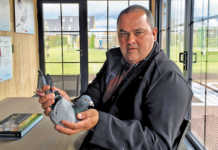
Few controversies polarise the sport of racing pigeons more than the ‘eye-sign’ theory. Briefly, this holds that the ‘look’ or structure of a pigeon’s eye will help to determine if the pigeon will be a great racer or breeder. Adherents use a jeweller’s loupe to examine the iris, the ‘circle of correlation’ between the iris and the pupil, the pupil, and the ‘inner muscle’ inside the outer rim of the pupil.
Many racing pigeon champions around the world attribute their success largely to studying the eyes of their birds. But just as many champions scoff at the theory.
“I think a vet would be highly amused to hear a big champion say you should never pair two white-eyed pigeons,” says one fancier. “Why would there be a difference between blue, white or green eyes?”
There are differences between eye-sign ‘experts’ too. One condemned my number one breeding pair; another complimented me on it!
Intense selection
Racing pigeons are not kept for their beauty, but for their racing prowess. They are distinguished from ‘show homers’ kept for showing. Because looks matter here, presumably their eye-signs are impressive. I say ‘presumably,’ because eye-sign selection is rarely practised in these instances, as the theory is aimed at selecting ace racers.
The irony is, with their (presumably) top notch eyes, good show pigeons rarely make good racers. For one thing, their orientation and homing ability tends to be poor.
When it comes to true racing pigeons, a fierce process of selection has taken place over the years, with enthusiasts studying both the genotype and phenotype. Intense breeding programmes based on inbreeding, line-breeding and/or crossbreeding are used. Fanciers select, test and re-select. Notes are made of the outcome of their efforts.
Given that selection criteria include an aerodynamic body conformation, good wing design and other physical attributes, it’s perhaps not surprising that someone decided to look at the eyes too.
Many fanciers believe they can grade intelligence, determination and health by studying a pigeon’s eyes. Only in pigeon racing could this happen, says fancier Bob Prisco at The Pigeon Insider (pigeonracingpigeon.com). Can you imagine judging a human athlete’s potential solely on the basis of eye-sign?
Little evidence
“There is little definitive scientific evidence on this subject,” says US racing pigeon expert Dr John Lamberton (drjohnlamberton.com). “As with many theories, the validity and reliability of eye- sign theory is strictly a matter of personal faith and preference.”
On the other hand, amidst all of the science, instinct plays a big role in selecting pigeons. “Every fancier has his own traditions, his own certainties and his own clues, which he tries to recognise when holding a real champion in the hand,” says Verheecke Marc at www.pipa. be. “Still, we all have to agree that our theories and ideas do not match reality very often.”
At the same time, there’s little doubt that some fanciers have a better ‘feeling’ for pigeons than others. More research is needed. Until then, I believe we cannot simply jettison eye-sign theory as a pseudoscience. There might just be more to it than, er, meets the eye.
Thomas Smit is a racing pigeon selector, and a freelance journalist and writer.











